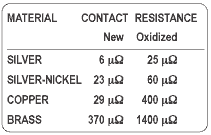Meltric plugs
& receptacles feature solid silver-nickel (85/15) butt contacts that
are similar to those used in contactors and switchgear. The combination of
the outstanding electrical properties of silver and the excellent
mechanical properties of nickel provide many advantages relative to common
brass contacts or silver-plated brass contacts.
• The hardness of
nickel makes the contacts wear resistant and helps provide
good mechanical endurance and long
operating lives.
•
The low contact resistance of silver and its
resistance to oxidation provide
excellent contact performance that
does not deteriorate significantly over time or with heat
and oxidation.
•
Silver-nickel only welds at extremely high
pressure and temperature and thus
can withstand arcs very
well.
• The strong
post-arc dielectric strength of silver-nickel helps reduce the duration
of arcs and the good mobility of
arcs on the material helps to prevent
arc-induced erosion of the
material.
By contrast, the brass material
commonly used for contacts in pin and sleeve devices is a relatively
poor conductor, has high contact resistance that increases significantly
with oxidation, and is not arc resistant. In addition, brass is a soft
material that wears rapidly under friction.
 |
|
The chart to the
left shows the dramatic difference in contact resistance between
silver-nickel and brass in both new and typical oxidized conditions. Even
in an oxidized state, the contact resistance of silver-nickel is more than
6 times less than the contact resistance of brass in its most favorable
(new) condition. Alternatively, when oxidized, the contact resistance of
brass is more than 20 times higher than oxidized silver-nickel. |
The high
contact resistance of brass creates additional heat. The heat causes more
oxidation, the oxidation further increases contact resistance, the
increased contact resistance causes more heat, and so forth. This vicious
cycle of degradation accelerates over time and is exacerbated by the
reduction in contact force caused by the frictional wear of the
material. The net result is diminished electrical performance, reduced
safety and shorter operational lives. This is why
Meltric does not use brass contacts.
|